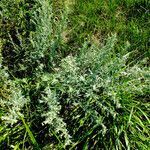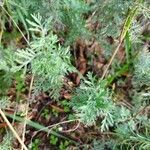Perennials, 40–100 cm, somewhat aromatic; rhizomes creeping, woody. Stems relatively numerous, erect, brown, mostly simple (brittle, bases woody) canescent or glabrate. Leaves cauline, grayish green; sessile (proximalmost short-petiolate); blades triangular to ovate, 1–5 × 1–3 cm, 2–3-pinnatifid (lobes 0.5–1 mm wide, acute), faces pubescent (abaxial) or hairy to glabrate (adaxial). Heads (nodding) in paniculiform arrays 10–22 × 2–4 cm. Involucres spheric, 1.5–2(–3) mm. Phyllaries (subequal) linear, hairy. Florets: pistillate 10–12; bisexual 40–45; corollas pale yellow, 0.2–0.3 mm, sometimes gland-dotted (stigma lobes relatively short, not emerging from tubes, short-ciliate). Cypselae ellipsoid (angled), 0.1–0.2 mm, glabrous. 2n = 18.
Rhizomatous perennial 4–10 dm, generally suffrutescent, simple or nearly so; lvs 1–3 cm, white-tomentose on both sides, more thinly so and sometimes eventually glabrate above, twice or thrice pinnatifid with short divergent segments scarcely 1 mm wide, ordinarily with a pair of stipule-like lobes or auricles at base; infl relatively narrow, elongate; invol 2–3 mm; achenes as in no. 1 [Artemisia abrotanum L.]; 2n=18. Dry open places; native of Europe, escaped and sparingly established in ne. U.S. and adj. Can. Aug., Sept.
A fleshy stemmed herb. It grows 80 cm tall and spreads 60 cm wide. It has underground stems or rhizomes. The leaves are long and feathery. They are compound and divided 1 or 2 times. They are greyish-green and downy. The flowers are small and yellow and in sprays.







